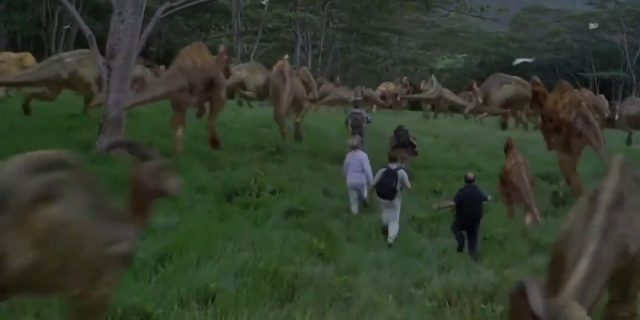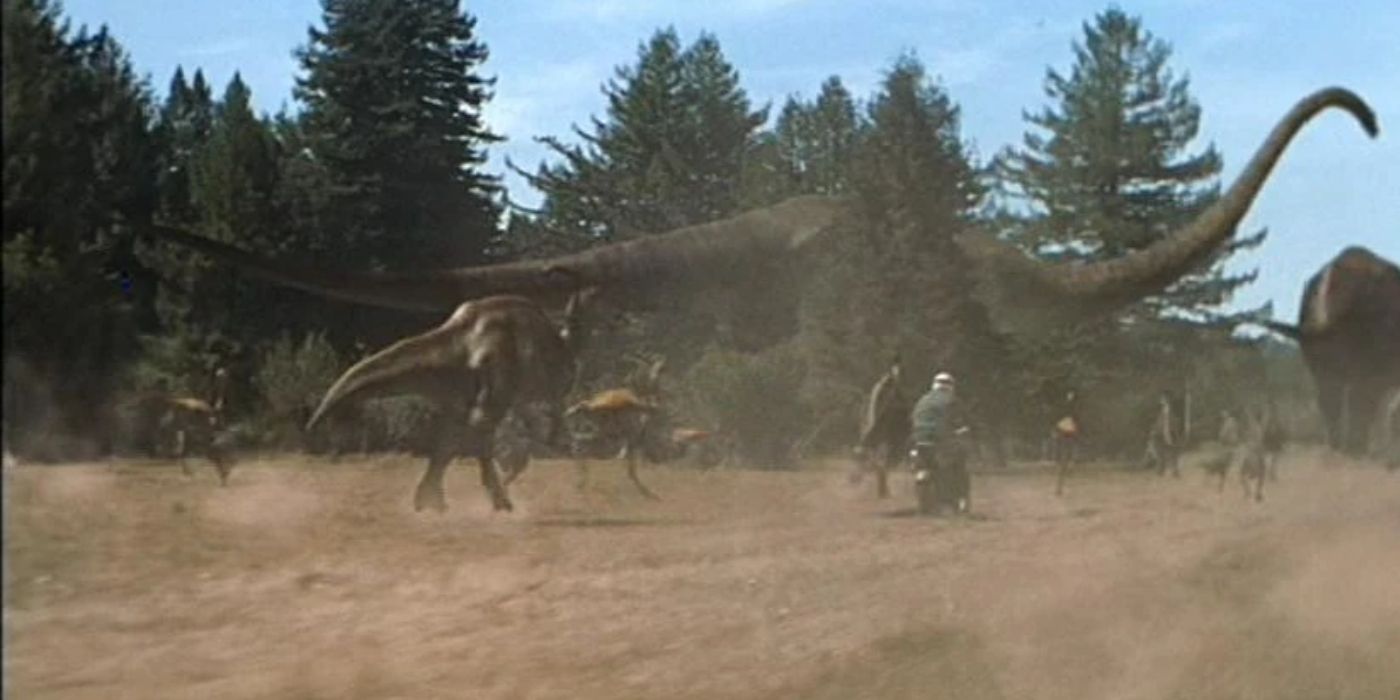Summary
- The Ceratosaurus and Corythosaurus are key dinosaurs from the original trilogy that fans want to see return for Jurassic World 4.
- Despite appearing in the original films, species like Mamenchisaurus and Spinosaurus have yet to make an appearance in Jurassic World.
- Jurassic World 4, the seventh installment in the series, still holds mystery as the cast remains unconfirmed, potentially excluding key characters.
The Jurassic Park franchise sees several dinosaur species in its films, but there are some from the original trilogy that don’t appear in any of the Jurassic World films and need to return for Jurassic World 4. The next movie, Jurassic World 4, will be the seventh installment in the series, not including the short films Battle at Big Rock and Jurassic World Dominion prologue or the TV show Jurassic World Camp Cretaceous. The highly anticipated film is yet to confirm a cast, and it’s possible that Chris Pratt’s Owen Grady and Bryce Dallas Howard’s Claire Dearing will not reunite.
As there are so many movies in the Jurassic Park franchise, it’s not surprising that some dinosaurs are seen on screen less than others. Interestingly, only four dinosaurs appear in every Jurassic Park movie out of an incredible 39 species that feature throughout the franchise. On the other hand, there isn’t a single dinosaur species that returns in all six films or its spinoffs. However, the Parasaurolophus comes closest and is only missing from the Jurassic World Dominion prologue. With Jurassic World 4 on the way, it’s worth looking at which dinosaurs from the original trilogy should make a return.
|
Jurassic Park Films (Original Trilogy) |
Release Date |
Jurassic World Films |
Release Date |
|---|---|---|---|
|
Jurassic Park |
1993 |
Jurassic World |
2015 |
|
The Lost World: Jurassic Park |
1997 |
Jurassic World: Fallen Kingdom |
2018 |
|
Jurassic Park III |
2001 |
Jurassic World Dominion |
2022 |
|
Relevant Dinosaurs |
Last Film Appearance |
|---|---|
|
Ceratosaurus |
Jurassic Park III |
|
Corythosaurus |
Jurassic Park III |
|
Mamenchisaurus |
The Lost World: Jurassic Park |
|
Spinosaurus |
Jurassic Park III |
4 Ceratosaurus
The Allosaurus’ Less Powerful, Yet Still Fearful, Cousin
The Ceratosaurus is a carnivorous species from the Late Jurassic period. In Greek, its name translates as horn lizard, an apt name for its appearance. According to researchers, the Ceratosaurus stands around five meters tall, with a defining deep jaw, a ridge-like spike in the middle of its snout, and matching horns above its eyes. Like the T-Rex, the Ceratosaurus has short forelimbs and small claws but moves around much more easily. Unfortunately, the Ceratosaurus lacks the same intelligence and speed that its cousin, the Allosaurus, possesses. In Jurassic Park‘s franchise, the Ceratosaurus is only seen in Jurassic Park III.
In the Jurassic Park franchise, the Ceratosaurus is a creation of InGen, a bioengineering company whose laboratories are seen throughout Jurassic Park III. Before the events of the film, the company clones and experiments on the dinosaurs and eventually frees them, and the species relocates itself to the north of Isla Sorna. Despite this, the species does not appear in Jurassic Park or The Lost World: Jurassic Park or receive a mention by name, so clearly, it is not considered interesting enough to be included as an attraction. In Jurassic Park III, the Ceratosaurus only appears in one brief scene.
When met with the towering, blood-red colored Ceratosaurus, the group panics and expects it to attack them.
While escaping the chaos, paleontologist Dr. Alan Grant (Sam Neill) and the Kirby family, Paul (William H. Macy), Amanda (Téa Leoni), and their son Eric (Trevor Morgan), encounter a Ceratosaurus along a riverbank. The group sifts through a pile of dung made by a Spinosaurus, another dinosaur from the franchise, in search of a satellite phone. When met with the towering, blood-red colored Ceratosaurus, the group panics and expects it to attack them. Instead of killing the group, the dinosaur walks away from them, but not without first giving them a cold stare that shakes them to their very cores.
The Ceratosaurus is a great dinosaur that Jurassic World 4 can bring back.
The Ceratosaurus is seen in the TV show Jurassic World Camp Cretaceous, making its first appearance in season 2. As the species does not appear in Jurassic World, it can be assumed that the Ceratosaurus is now extinct. However, as this has never been officially confirmed, there’s still a chance the species can return in Jurassic World 4. The Ceratosaurus is a great dinosaur that Jurassic World 4 can bring back. Not only is the Ceratosaurus ridiculously underused in the original trilogy, but audiences deserve to know what happens to them after the events of Jurassic Park III.
3 Corythosaurus
The Cause Of One Of The Biggest Stampedes In Jurassic Park
The Corythosaurus is from the late Cretaceous period. The species is easily identifiable for its unique face, which has a duck-billed mouth, a narrow snout, and a helmet-shaped head. It’s also recognizable for the bony crest in its skulls, although researchers claim that the size differs depending on the sex of the prehistoric creature. The Corythosaurus’ first mention is in passing in The Lost World: Jurassic Park, but isn’t seen on-screen until Jurassic Park III. However, the Corythosaurus is a scientifically inaccurate dinosaur in Jurassic Park and its sequels.
Unfortunately, the species only appears in a short scene in Jurassic Park III.
In the original script and the novelization of the film, entitled The Lost World: Jurassic Park (Mighty Chronicles), the species is referred to as the “Carninthosaur.” Unfortunately, the species only appears in a short scene in Jurassic Park III. The Corythosaurus species are another creation of InGen and are kept in captivity until the antagonistic company abandons the labs and releases them into the wild, in a series of off-screen events that lead up to the first film. Although they do not appear in the first two movies, the Corythosaurus is referenced on the mural in the visitor center restaurant.
After this scene, the Corythosaurs aren’t seen again, making their fate unknown.
As Dr. Grant, Amanda, Paul, Billy Brennan (Alessandro Nivola), and Udesky (Michael Jeter) are being chased by a pack of Velociraptors, they escape the InGen compound and into an open field. In a flurried rush, they bolt across the landscape and through a herd of Corythosaurs and Parasaurolophus’, who are grazing on the surrounding grass. Their sudden and panicked movement causes a dangerous stampede, and each of them is knocked to the ground by the huge Corythosaurus storming past them, which splits the group up from one another. After this scene, the Corythosaurs aren’t seen again, making their fate unknown.
The Corythosaurus is mentioned by name in the Jurassic World trilogy, however. For example, in Jurassic World: Fallen Kingdom, the Corythosaurus is notably absent, and the film implies that the species doesn’t survive the events of Jurassic Park III, although it is an indirect reference. The Corythosaurus is also mentioned in relation to Jurassic World: Dominion by the website of the film’s viral marketing campaign (via dinotracker.com). According to the fictional Department of Prehistoric Wildlife, the species still lives in a herd with the Parasaurolophus and some may be possibly kept in an illegal breeding operation in Finsbury Park, London.
2 Mamenchisaurus
Jurassic Park’s Iconic Herbivore
The Mamenchisaurus is a genus of sauropod dinosaurs and one of the few species whose geological age is currently unknown. It can easily be spotted because of its incredibly long neck, taking up nearly half of its total body length, which varies from 15 to 26 meters, with an astonishing 19 vertebrae, too, which keeps its structure strong and secure. The Mamenchisaurus also has a very long tail and short and stubby legs. Unlike several of the other dinosaur species in the Jurassic Park franchise, the Mamenchisaurus is a herbivore, with sharp teeth that let it tear through plants easily.
The design of the Mamenchisaurus is very intriguing. In the book The Making of The Lost World: Jurassic Park by Jody Duncan, it is explained that the species’ appearance started as a sketch and then colorized. However, the Mamenchisaurus’ CGI model is actually a modification of the Brachiosaurus model from the first film, stretching out its neck, elongating its head, and adding a whip-like tail. These alterations are a product of visual effects artist Ken Bryan, who is also the digital modeler for the incredible CGI in Eragon, Iron Man, and the Harry Potter film series.
The species is only seen in The Lost World: Jurassic Park, but it causes plenty of destruction in its on-screen appearance.
Like other species, the Mamenchisaurus is a product of InGen’s meddling. The species is only seen in The Lost World: Jurassic Park, but it causes plenty of destruction in its on-screen appearance. While InGen’s hunters began rounding up the island’s wild dinosaurs, two Mamenchisaurus stepped out of the forest and into an open field. This moment is observed by InGen’s CEO and the main villain of the film, Peter Ludlow (Arliss Howard). In this scene, Ludlow shares his amazement at the size of the creatures, barely noticing the multiple cars and motorbikes swerving in and out of the Mamenchisaurus’ legs.
Although they don’t appear in the Jurassic World films, they seem to be extinct, although audiences are aware that this can still change.
Similar to many of the dinosaurs in the Jurassic Park movies, it is unknown whether the Mamenchisaurus species is still around. Although they don’t appear in the Jurassic World films, they seem to be extinct, although audiences are aware that this can still change. According to dinotracker.com, the Mamenchisaurus may have been recreated at some point in 2022, the same year of release as Jurassic World: Dominion, which implies that they are being kept in mind as a returning species for the future. If the population is still in existence, hopefully, they will be brought back for Jurassic World 4.
1 Spinosaurus
Jurassic Park III’s Biggest Hazard
The Spinosaurus, from the late Cretaceous period, is a huge threat in Jurassic Park III, but its depiction is scientifically inaccurate in comparison to the actual prehistoric creature. According to researchers, the Spinosaurus is one of the largest theropod dinosaurs and is semi-aquatic due to its short yet powerful hind legs that help it balance itself both in water and on land. It also supposedly has skin similar to that of an alligator, a wild animal that has frequently been compared to dinosaurs. However, in Jurassic Park III, the Spinosaurus looks different for a few different reasons.
Due to the timing of its release in 2001, it is not a surprise that Jurassic Park III fails to be completely scientifically accurate
For example, the Spinosaurus’ legs are too large, a crucial detail in the species’ appearance. It also has an oversized head, whereas the actual Spinosaurus is known for having a narrow snout. Due to the timing of its release in 2001, it is not a surprise that Jurassic Park III fails to be completely scientifically accurate. However, the film depicts the species as just another land creature and misses an opportunity to delve further into its semi-aquatic qualities. Out of six Jurassic Park movies, the Spinosaurus is only featured in Jurassic Park III.
The Spinosaurus is one of the few dinosaur species that is cloned off-screen in the Embryonics Administration laboratory, and after they cover up its existence, is finally freed back into the ecosystem. The species then pops up a few times throughout Jurassic Park III. For example, when Eric learns that T-Rex urine can be used to scare off some of the park’s smaller dinosaurs, he also realizes that it attracts the Spinosaurus and makes it territorial. Later on, when the group tries to locate a missing Eric, one of the Kirby’s mercenaries, Cooper (John Diehl), shoots at a Spinosaurus.
Considering the destruction that the Spinosaurus causes in Jurassic Park III, it’s surprising that the dinosaur doesn’t return in the Jurassic World films, although there’s still hope for Jurassic World 4.
Unfortunately, the dinosaur takes offense to this and injures Cooper’s arm. The Spinosaurus then tracks Cooper and his team down as they board the plane but devours one of the mercenaries as they take off, which causes the aircraft to crash into its body. It later tracks down the wreckage, yanks off the cockpit with its strong jaws, and pulls pilot M.B. Nash (Bruce A. Young) to his death. Considering the destruction that the Spinosaurus causes in Jurassic Park III, it’s surprising that the dinosaur doesn’t return in the Jurassic World films, although there’s still hope for Jurassic World 4.
Jurassic World 4
Jurassic World 4 is the seventh film in the Jurassic Park franchise and continues the story of Jurassic World: Dominion. Written by David Koepp, Jurassic World 4 will begin a new era for the Jurassic franchise.
- Distributor(s)
- Universal Pictures
- Writers
- David Koepp






